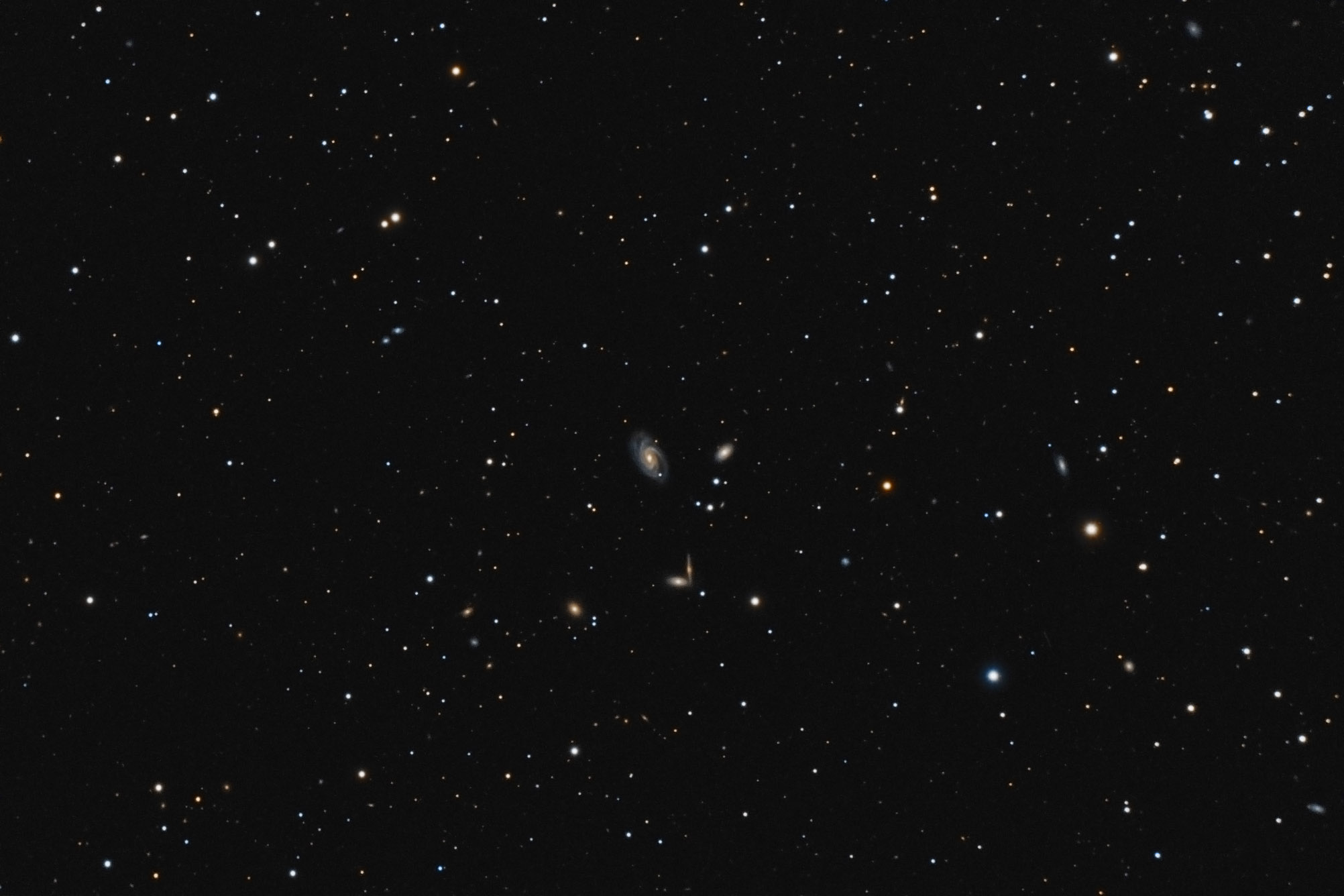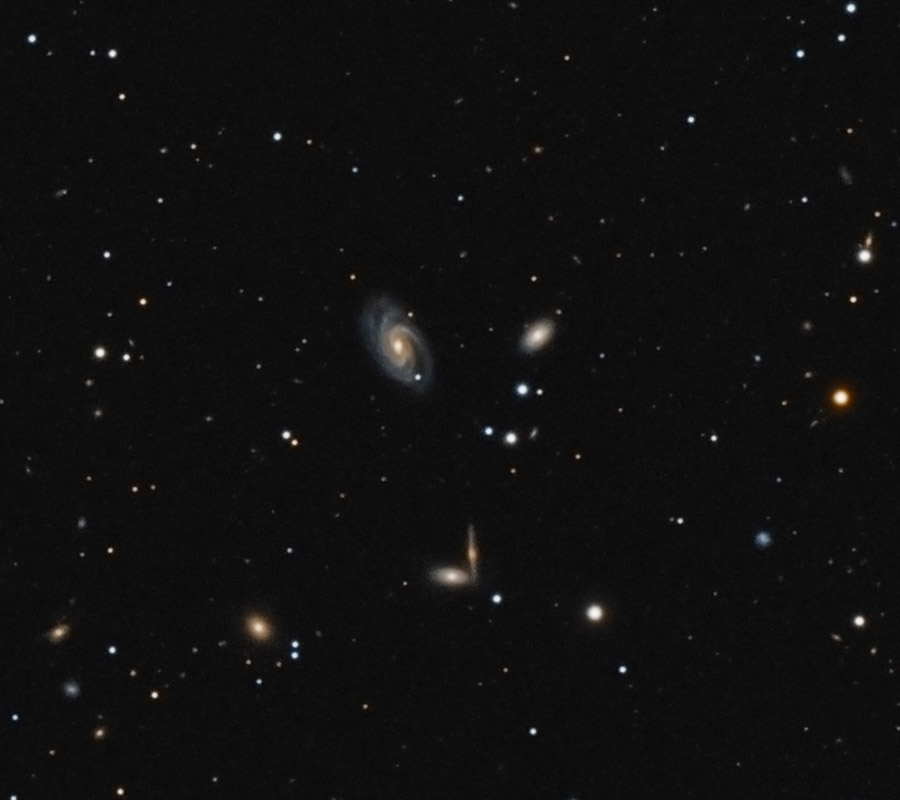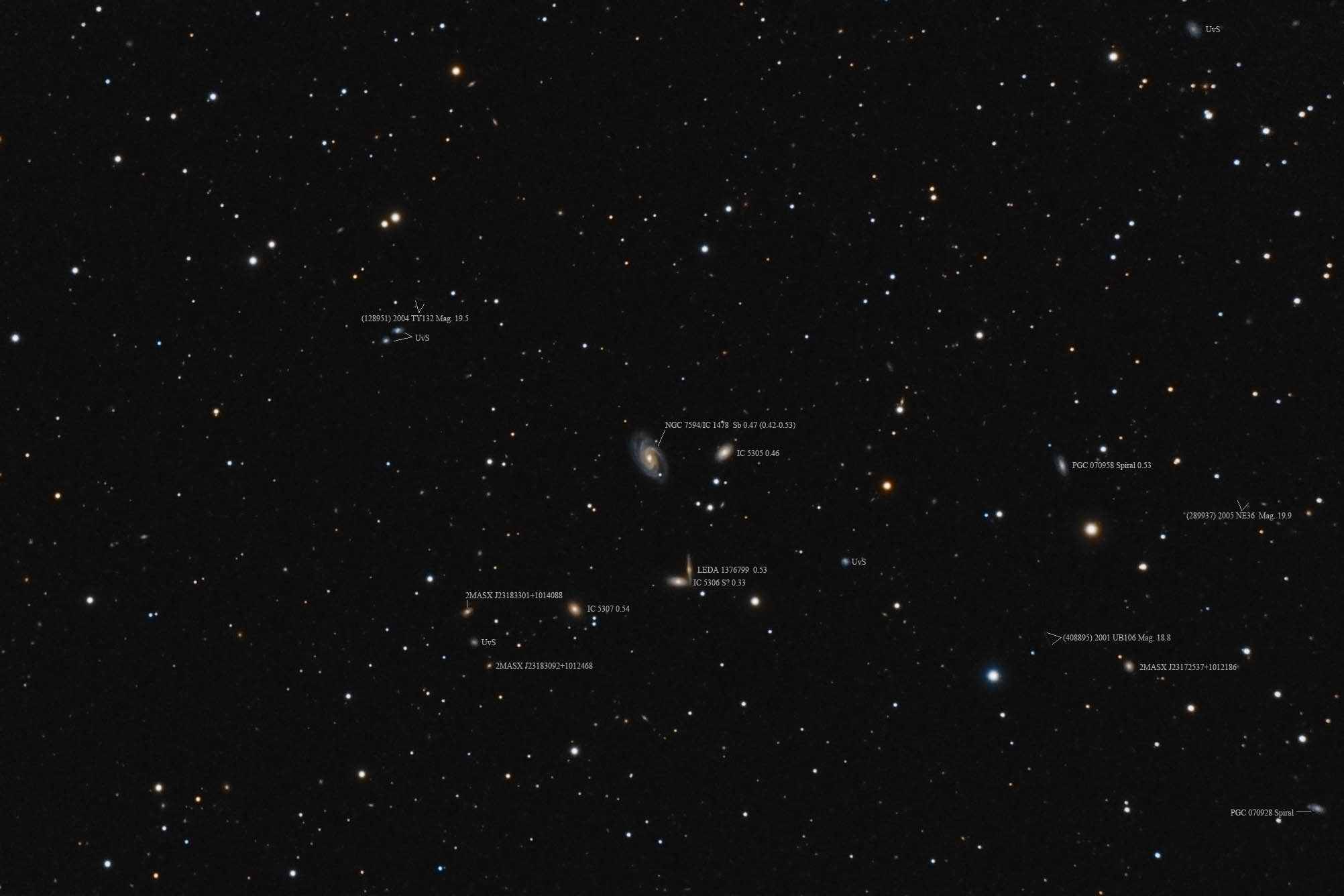Object name: NGC7594Designation(s): NGC7594, IC1478, IC5305, IC5306, IC5307, The WBL 706 galaxy group has three members. They are NGC7594, IC 5305 and the double galaxy of LEDA 1376799 and IC 5306 though IC 5306 is only a line of sight galaxy. The three true members are all about a half billion light-years distant. NGC 7594 is an Sb galaxy with a redshift distance of 470 million light-years but on-redshift measurements have a median value of 420 million light-years and a mean value of 530 million light-years. IC 5305 shows a redshift of 460 million light-years while LEDA 1376799 has the largest redshift of 530 million light-years. The outcast IC 5306 is only 330 million light-years distant by redshift. Though other galaxies are apparently true members of the group such as IC 5307 at 54 million light-years and PGC 070958 at 53 million light-years they aren't part of the WBL group for some reason (too far away from the other three by angular measurement? The group is located in Pegasus below the Great Square.
Since these are quite distant galaxies but have a reasonable angular size they must be huge. NGC 7594 is about 200,000 light-years across making it one of the largest known spiral galaxies. LEDA 1376799 is 131,000 light-years in diameter while IC 5305 is only 80,000 light-years in size. I should probably mention that measuring the size of such distant galaxies has an additional complication not found with nearer galaxies. During the half billion years the light has been heading our way the universe has expanded. So while we see these galaxies at one distance they were closer when the light left. We see their size as it would be if they were at the distance they were when the light left but measure their distance in light travel time as greater. That means we get a size that is too large. In fact, we call its distance when the light left its angular size distance. At some point this difference is material. I usually round distances to only two significant digits so it hardly matters in most cases. But since I get asked about it decided its time to address this issue. In the case of NGC 7594, its angular size distance is about 2 megaparsecs closer. If I use the redshift look back distance to calculate its size and use all 3 significant digits at NED (0.473) and its measured size on my FIT of 90 arc seconds that makes it 206,000 light-years across. Using its Angular Size Distance of 143 megaparsecs (0.466) its size is 203,000 light-years. Being conservative I used 200,000 above as I round to 2 significant digits since the calculation was done using 3. I always use one less significant digit in these posts. Since the two values are on opposite sides of the rounding point if I'd have used the look back distance for the calculation it would have been 210,000 which is too big by 5%. Since there are so many error bars involved here even using 200,000 might be a bit overstating the actual accuracy of the computation. I could throw out that during the half billion years the light was on the way the galaxy actually moved further away than the light travel time indicates and it is now really 148 megaparsecs distant (482 million light-years). I'm assuming values NED uses for their 5 year WMAP calculations. Change these values and the distances change accordingly. New values come out every few months. I've stuck with these over the years to make all my posts comparable. If I kept changing each time a new value came out I'd have to change all prior posts to match and with over 1000 of them now that is impossible. Again the various error bars involved and my rounding likely makes this difference rather immaterial.
NGC 7594 was discovered twice. First by Andrew Commen in August 1880 and again by Guillaume Bigourdan on August 22, 1889. The latter was entered into the IC catalog as IC 1478. This is why I listed both on the annotated image. Andrew Commen was an English astronomer who used a 36" f/5.9 reflector. He later sold this in 1885 to a rich carpet baron on England by the name of Edward Crossley who set up his own observatory using the scope. But English weather got the best of him and gave up the astronomy side of his life. He donated scope and dome to Lick Observatory where it was known as the Crossley reflector for its donor. It was only recently retired from research service. http://www.ucolick.org/public/telescopes/crossley.html
IC 5305, 5306 and 5307 were discovered in 1897 by Hermann Kobold using an 18" refractor at Strasbourg Observatory. He found 38 IC objects but 4 turned out to be stars. The majority of his discoveries were galaxies in the Coma Cluster.
This field is poorly mapped. Only a few galaxies had redshift values. Most have no redshift. Those listed by NED are mostly from the 2MASS catalog and often don't even have a magnitude. Most of the background galaxies, however, don't emit enough 2 micron radiation to make that survey. Those that are strong in Ultraviolet made the Galex satellites catalog of Ultraviolet Sources (UvS) but so far NED lists those solely as UvS. Most are stars, some galaxies but NED makes no distinction. Also, the resolution and pointing accuracy of the satellite was low by today's standards so the positions are somewhat vague. Since the annotated image was rather sparse due to lack of redshift data I included the brighter 2MASS objects by designation (just their coordinates in the sky). I didn't even do that with the UvS galaxies I noted. Just listing them as UvS. Many more UvS and 2MASS galaxies are in the image. I didn't see much use in pointing the few remaining 2MASS galaxies out and separating galaxies from stars in the Galex catalog is a super time-consuming task with hundreds to go through. Probably why NED hasn't done so as yet.
There are three asteroids in the image. See the annotated image for details.
I should note I have no idea why I took this group. It isn't to be found on my to-do list in any category. That means I had to interrupt the auto selection process and go to it manually. Something I rarely do unless a supernova, comet, near earth asteroid or other in the news object, comes up. That doesn't seem to be the case here. I did enter it in the log under the NGC 7594 designation, not the galaxy group designation which is also odd. I made no note however as to why it was taken. While the edge on galaxy made the 2 micron flat galaxy catalog it isn't thin enough for the Flat Galaxy Catalog so that isn't the reason, besides I'd have logged it under that galaxy, not NGC 7594. Apparently, I figured I'd remember why when I processed it but I don't. The why will have to remain a mystery.
14" LX200R @ f/10, L=4x10' RGB=2x10, STL-11000XM, Paramount ME Related Designation(s):2MASS J23180621+1017595, 2MASS J23181132+1014458, 2MASS J23181392+1017541, 2MASS J23182202+1014086, 2MASX J23180621+1017598, 2MASX J23181133+1014457, 2MASX J23181391+1017537, 2MASX J23182204+1014088, AGC 330208, CGCG 2315.6+0958 NED02, CGCG 2315.6+1002, CGCG 2315.7+1002, CGCG 431-036 NED02, CGCG 431-037, CGCG 431-038, GALEXASC J231806.20+101759.8 , GALEXASC J231822.01+101408.9 , IC 1478, IC 5305, IC 5306, IC 5307, IC1478, IC5305, IC5306, IC5307, LEDA 214932, MCG +02-59-021, MCG +02-59-022, MCG +02-59-023, NGC 7594, NGC7594, NPM1G +09.0600, NPM1G +10.0584, NSA 151040, NSA 151051, NSA 169007, NSA 169012, NVSS J231806+101746, PGC 070987, PGC 070991, UGC 12485, UGC 12485 NOTES02 NED02, UZC J231806.2+101759, UZC J231814.0+101753, WBL 706-002, WBL 706-003, | | 

